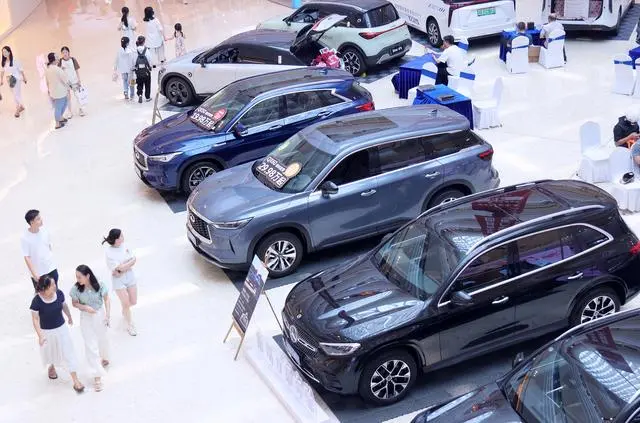
In recent years, the penetration rate of new energy vehicles has shown a rapid growth trend. Data released by the Passenger Vehicle Market Information Joint Branch of the China Automobile Dealers Association on August 8th showed that in July, the retail sales of passenger vehicles in the country reached 1.72 million units, among which the retail sales of new energy passenger vehicles were 878,000 units. The single-month retail penetration rate exceeded 50% for the first time, reaching 51.1%, an increase of 15 percentage points compared to the same period last year.
Achieving this historic milestone was 11 years ahead of the original plan. The “Development Plan for the New Energy Vehicle Industry (2021-2035)” pointed out that through 15 years of continuous efforts, pure electric vehicles are striving to become the mainstream of new vehicle sales.
Industry insiders generally believe that the penetration rate of new energy vehicles exceeding 50% is a significant sign of China’s green transportation and the transformation and upgrading of China’s manufacturing industry. While new energy vehicles have received more support and recognition from consumers at the market terminal, China’s automotive industry is undergoing profound changes.
This change is not only reflected in the sales end. On August 6th, the National Development and Reform Commission, the National Energy Administration, and the National Data Administration issued the “Action Plan for Accelerating the Construction of a New-Type Electric Power System (2024-2027)” (hereinafter referred to as the “Plan”). The “Plan” proposed to strengthen the integrated interaction between electric vehicles and the power grid; make full use of the energy storage resources of electric vehicles and fully promote intelligent and orderly charging; support the exploration of the integrated interaction of vehicles, piles, stations, and networks, study and improve the time-of-use electricity price policy for electric vehicle charging, explore the discharge price mechanism, and promote the participation of electric vehicles in the power system interaction.
Taking battery technology as an example, in recent years, battery energy density has continuously increased, the cruising range has significantly increased, and the charging time has continuously shortened, making new energy vehicles gradually approach fuel vehicles in terms of convenience of use. At the same time, the wide application of intelligent technology has also added strong competitiveness to new energy vehicles. Functional applications such as intelligent driving and intelligent cockpits not only enhance the safety and comfort of driving but also meet consumers’ pursuit of technology and intelligence.
In addition, under the support of the “trade-in for new” policy, various regions are intensively promoting the renewal of transportation equipment and the replacement of new energy vehicles in urban public transportation. Recently, Shanghai, Hubei, Jiangsu and other places have successively introduced relevant policies, putting forward clear requirements for the proportion of new energy buses, taxis, and online car-hailing.
Take Shanghai as an example. The “Special Work Plan for Large-scale Facility and Equipment Renewal in the Transportation Field in Shanghai (2024-2027)” proposed that by the end of 2027, buses and taxis in Shanghai are expected to fully achieve new energy transformation, with an average annual renewal of vehicles exceeding 9% of the total.
Industrial transformation, in the final analysis, is a breakthrough in technological innovation. Industry experts said that the penetration rate of domestic passenger vehicles in new energy exceeding 50% and the popularization of the new energy vehicle market has reached a new level, mainly due to the empowerment of the industrial chain advantages brought by the continuous strengthening of China’s manufacturing industry. The maturity, improvement, and scale effect of China’s new energy vehicle industrial chain provide a solid backing for its development. From the research and development of battery raw materials to the manufacturing of new energy vehicle components, and then to the construction of the Internet ecosystem, the entire industrial chain works together to accelerate the process of electrification and intelligence.
Public data shows that in the past four years, the research and development investment of China’s mainstream automotive brands has been 2.5 times that of four years ago. Take BYD as an example. In 2023, BYD’s annual research and development investment increased by 97% year-on-year to nearly 40 billion yuan, and the cumulative research and development expenditure since announcing vehicle manufacturing has exceeded 140 billion yuan. One by one, the patents of domestic independent brands have been transformed into productivity, continuously providing consumers with rich and diverse driving experiences.
The penetration rate of new energy vehicles exceeding 50% not only provides impetus for industrial upgrading but also opens up broad space for Chinese automobiles in the international market. In 2023, China ranked as the world’s largest auto exporter with a result of 4.91 million units. In the era of new energy vehicles, Chinese auto companies not only rank among the world’s forefront but also achieve reverse technology output to joint ventures, demonstrating strong innovation capabilities. BYD, Geely, Changan, Chery, SAIC, etc. have been listed on the TOP20 list of global automotive groups.
More News:chinaautonews.com.cn
More products:bymotorcar.com/products/


